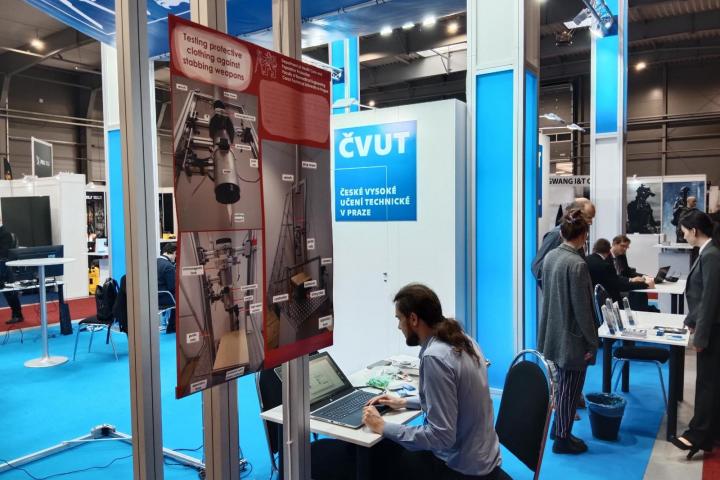FEL CTU is represented by scientific groups from the Department of Computers and the Department of Measurement.
The Faculty of Biomedical Engineering presents exhibits of two scientific teams that aim part of their research activities at the field of security and military applications.
Incoming Fire Identification System and Virtual Laser Range
Artificial intelligence procedures are also applied in the projects developed by the Department of Measurement at FEL. In Letňany, among other things, they will present a system for identifying incoming fire, which can recognize the type of weapon from which the shot was fired, as well as the type of ammunition. For this, self-learning neural networks need a database of shots recorded or sensed acoustically.
"We are working on developing stationary systems that can distinguish a gunshot from other similar sounds with 99% reliability, but also locate the position of the shooter. Similar systems are used, for example, by schools, authorities and other public institutions in the United States in case of terrorist attacks," says Prof. Jan Holub, head of the Department of Measurement at FEL.
In Letňany, his department will also present a virtual and laser shooting range and a number of other technologies that respond to the needs of contemporary security and military institutions.
Autonomous reconnaissance system and multi-robotic platform for tackling challenging terrain
At the CTU stand, visitors can get acquainted with multirobotic platforms for overcoming difficult terrains. The six-legged walking robots Lily and SCARAB II represent robotic platforms capable of autonomously exploring inaccessible terrains, including underground spaces or caves without GPS signal availability. A set of multi-robotic systems from Faculty of Electrical Engineering successfully participated in last year's finals of the DARPA Subterranean Challenge, an unofficial "Robot Olympics" competition organized by the U.S. government agency.
Multi-robotic platforms are able to explore the terrain autonomously, without operator intervention, even in difficult conditions of reduced visibility and locate objects of interest. Autonomous control systems used in exploration are among the breakthrough technologies, the research and development of which is carried out by Laboratory of Computational Robotics at Department of Computer Science under the leadership of Prof. Jan Faigl.
Sensor networks and vital signs monitoring within the military medicine section
Doc. Miroslav Bureš from Department of Computers of FEL will present on Sensor Networks and Monitoring of Life Functions in Military Medicine on Thursday at 10.00 a.m. as part of the Medical Conference programme.
Sensor network technology is becoming readily available - and has many promising applications in military and civilian medicine. Monitoring the vital signs of soldiers can be useful in applications such as the care of those injured in combat, follow-up treatment of wounded soldiers, or clinical trials. The presentation introduces the concept of medical sensor networks; it also shows possible use cases in three recent experimental projects in military and civilian medicine, a collaboration between the University of Defence, the Czech Technical University in Prague and other partners.
The Biomechanics and Assistive Technology research team will present several projects they are currently working on:
A device that enables recording and simulation of the force effects of small arms during firing.. Teamlaeder doc. Ing. Patrik Kutílek, MS.c., Ph.D., adds: "The device also enables the measurement of the movement of the weapon and the shooter during firing and the assessment of the postural stability of the shooter's body."
A device for measuring the mental and physical state of people in ICE (isolated, confined, extreme) environments, consisting of a camera system and a wearable physiological data measurement system, which allows to estimate the emotional and concentration state of crew members in ICE environments, and also continuously assesses the health status of team members.
A system for measuring the posture of army specialists consisting of cameras and force measurement platforms allowing to measure and evaluate the position of body segments and the position of the centre of gravity of the body during a medical examination and to assess the health of the musculoskeletal system by this measurement.
Testing of protective clothing against stabbing weapons: A sample of stabbing weapon samples for testing protective clothing against stabbings. The semi-automatic testing equipment allows testing of materials according to standards with different force effects and types of spikes.
A team from Department of Information and Communication Technologies in Medicine presents the Intelligent Security Surveillance System for soldiers and members of the IZS (Integrated rescue system). "It is a multi-sensor monitoring system based on artificial intelligence designed to reduce risk, protect the health and safety of soldiers and members of the IZS in real time and to support the commander's decision-making. The system can be used for mass monitoring during routine operations as well as during CBRN incidents in difficult terrain," adds doc. Ing. Pavel Smrčka, Ph.D. from FBMI.



